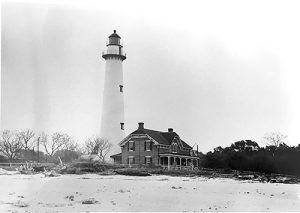Learn about South Carolina lighthouses in free lecture at Relic Room
March 14, 2023Debbie Mollycheck’s father was born in a lighthouse – technically, in the keeper’s house attached to the lighthouse in St. Simons, Ga., where her grandfather was the assistant keeper.
After her father died at an early age in 1983, Debbie went to visit the lighthouse, which was in the early stages of becoming a museum, and the curator told her she was mistaken – her father had not been born there, because according to the records on hand, no one of her grandfather’s name had ever been keeper.
Debbie knew the curator was wrong, and years later set out to prove it, and has spent the past decade studying lighthouses and those who served in them. She will share what she has learned in a free lecture at the South Carolina Confederate Relic Room and Military Museum at noon on Friday, March 24. The lecture, “South Carolina Lighthouses,” is part of the museum’s monthly Lunch and Learn program.
If you want to read in advance about some of the things she has learned, check out her website, https://mollycheck.com/.
Franto Mollycheck II was born on the family farm in Mount Pleasant in 1902. Debbie and her four siblings would later grow up on the same farm. But when he was 20, Franto reached a point where he’d had enough of farm life. He walked three miles to the water’s edge, and took a ferry to Charleston, where the headquarters of the Sixth Lighthouse District was located. He became a sailor with the Lighthouse Service, working on the tenders that supplied and supported the towers up and down the coast from Jupiter, Fla., in the south to Southport, N.C., in the north.
Later, he become a lighthouse keeper. He was the assistant in St. Simon’s when his son, Franto III – known as “Frank” – was born in 1929.
The keeper’s life was a hard one, more so than you might imagine. When stationed at Southport in 1937, Franto had a heart attack from the strain of loading a container of fuel for the light into a small boat. He was only 35. It permanently weakened his heart, and he had to retire on disability in 1951.
Things had changed during those years. In 1939, the U.S. Lighthouse Service became a part of the U.S. Coast Guard. Franto didn’t don the uniform – Lighthouse Service personnel were given that option – but that’s who he worked for and with. Some uniformed Coast Guardsmen were stationed with him in Southport, and Debbie’s website has some good pictures of them.
Debbie is an attorney, having been admitted to the bar in 1984 after graduating from the University of South Carolina School of Law. She still helps out family and friends with legal issues, but since 2016, she has devoted her time fully to researching the Lighthouse Service, learning about what her grandfather, other keepers, the tender crews, pilots and others did to keep ships safe along our coast.
Her research has taken her to the National Archives in Washington, and to Atlanta, where the Lifesaver Logs are kept. She found her grandfather’s full service records, and those of seven keepers who served at the Southport light before him. Her primary research has not only demonstrated that the curator was wrong, but that others had been as well.
She had read that there had been no black keepers during the history of the lighthouses. But she learned that the very first of her grandfather’s predecessors at Southport had been African-American – and held the post from 1885 to 1920.
She’s learned those things, and a lot more. Come hear her tell about them on March 24.
About the South Carolina Confederate Relic Room and Military Museum
Founded in 1896, the South Carolina Confederate Relic Room and Military Museum is an accredited museum focusing on South Carolina’s distinguished martial tradition through the Revolutionary War, Mexican War, Civil War, Spanish-American War, World Wars I and II, Vietnam, the War on Terror, and other American conflicts. It serves as the state’s military history museum by collecting, preserving, and exhibiting South Carolina’s military heritage from the colonial era to the present, and by providing superior educational experiences and programming. It recently opened a major new exhibit, “A War With No Front Lines: South Carolina and the Vietnam War, 1965-1973.” The museum is located at 301 Gervais St. in Columbia, sharing the Columbia Mills building with the State Museum. For more information, go to https://crr.sc.gov/.














